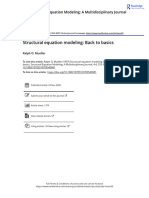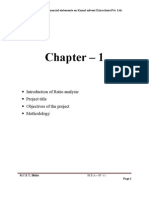JCN 10 774 Wald Test
JCN 10 774 Wald Test
Uploaded by
Enggar Rindu PrimandaniCopyright:
Available Formats
JCN 10 774 Wald Test
JCN 10 774 Wald Test
Uploaded by
Enggar Rindu PrimandaniOriginal Title
Copyright
Available Formats
Share this document
Did you find this document useful?
Is this content inappropriate?
Copyright:
Available Formats
JCN 10 774 Wald Test
JCN 10 774 Wald Test
Uploaded by
Enggar Rindu PrimandaniCopyright:
Available Formats
774 H. KyngaÈs and M.
Rissanen
INFORMATION POINT: The Wald test is a way of testing the signi®cance of particular explanatory
variables in a statistical model. In logistic regression we have a binary
Wald test outcome variable and one or more explanatory variables. For each
explanatory variable in the model there will be an associated parameter.
The Wald test, described by Polit (1996) and Agresti (1990), is one of a
number of ways of testing whether the parameters associated with a group of
explanatory variables are zero.
If for a particular explanatory variable, or group of explanatory variables,
the Wald test is signi®cant, then we would conclude that the parameters
associated with these variables are not zero, so that the variables should be
included in the model. If the Wald test is not signi®cant then these
explanatory variables can be omitted from the model. When considering a
single explanatory variable, Altman (1991) uses a t-test to check whether the
parameter is signi®cant. For a single parameter the Wald statistic is just the
square of the t-statistic and so will give exactly equivalent results.
An alternative and widely used approach to testing the signi®cance of a
number of explanatory variables is to use the likelihood ratio test. This is
appropriate for a variety of types of statistical models. Agresti (1990) argues
that the likelihood ratio test is better, particularly if the sample size is small or
the parameters are large.
Further reading
Agresti A. (1990) Categorical Data Analysis. John Wiley and Sons, New York.
Altman D.G. (1991) Practical Statistics for Medical Research. Chapman & Hall,
London.
Polit D. (1996) Data Analysis and Statistics for Nursing Research. Appleton & Lange,
Stamford, Connecticut.
NICOLA CRICHTON
Ó 2001 Blackwell Science Ltd, Journal of Clinical Nursing, 10, 767±774
You might also like
- Mini-Assignment 1 PDFDocument3 pagesMini-Assignment 1 PDFBhavish Grandhi100% (1)
- Reliability and Quality Management PDFDocument174 pagesReliability and Quality Management PDFFathirGangguanJiwa33% (3)
- Applied Multivariate Statistical Analysis Solution Manual PDFDocument18 pagesApplied Multivariate Statistical Analysis Solution Manual PDFALVYAN ARIFNo ratings yet
- Tech Talk-Creating A Social Media StrategyDocument25 pagesTech Talk-Creating A Social Media StrategyDEWASHISH RAI0% (2)
- Dr. SK Ahammad Basha Non Parametric Tests 1Document37 pagesDr. SK Ahammad Basha Non Parametric Tests 1shruti pachareNo ratings yet
- Chap10 ReviewerDocument3 pagesChap10 ReviewerYhel TrinidadNo ratings yet
- Anderson Et Al. 2000 PDFDocument13 pagesAnderson Et Al. 2000 PDFAkarsh MishraNo ratings yet
- Osborne (2008) CH 22 Testing The Assumptions of Analysis of VarianceDocument29 pagesOsborne (2008) CH 22 Testing The Assumptions of Analysis of VarianceShawn A. WygantNo ratings yet
- ANOVADocument10 pagesANOVATilak MishraNo ratings yet
- Quantifying Effects in Two-Sample Environmental Experiments Using Bootstrap Confidence IntervalsDocument13 pagesQuantifying Effects in Two-Sample Environmental Experiments Using Bootstrap Confidence Intervalsgautamsethi8561No ratings yet
- Understanding The Independent-Samples T TestDocument8 pagesUnderstanding The Independent-Samples T TestpsykohaxkNo ratings yet
- Anderson DarlingDocument5 pagesAnderson Darlingdontwantanaccount0% (1)
- Differences and Similarities Between ParDocument6 pagesDifferences and Similarities Between ParPranay Pandey100% (1)
- Paper of Statistic1Document4 pagesPaper of Statistic1Farmacia clinicaNo ratings yet
- Lecture 12.1 MA SR GuidelinesDocument43 pagesLecture 12.1 MA SR GuidelinesArokiasamy JairishNo ratings yet
- Mann Whitney U Test: ENS 185 - Data AnalysisDocument100 pagesMann Whitney U Test: ENS 185 - Data AnalysisClarkNo ratings yet
- Types of Data, Descriptive Statistics, and Statistical Tests For Nominal DataDocument13 pagesTypes of Data, Descriptive Statistics, and Statistical Tests For Nominal DataRaphael MutucNo ratings yet
- Non Parametric TestDocument15 pagesNon Parametric TestAreeb BaqaiNo ratings yet
- Comparison of T vs. Wilcoxon Signed Rank TestDocument17 pagesComparison of T vs. Wilcoxon Signed Rank TestMaricen ReyesNo ratings yet
- Non Parametric TestDocument16 pagesNon Parametric TestVIKAS DOGRA100% (1)
- New Normal MPA Statistics Chapter 2Document15 pagesNew Normal MPA Statistics Chapter 2Mae Ann GonzalesNo ratings yet
- Diagnostic TestDocument12 pagesDiagnostic TestEdmund HizaNo ratings yet
- Student's T TestDocument12 pagesStudent's T TestZvonko TNo ratings yet
- Test of NormalityDocument7 pagesTest of NormalityDarlene OrbetaNo ratings yet
- Chapter 1 Data AnalysisDocument18 pagesChapter 1 Data AnalysisGahnzelle Eidref FerreriaNo ratings yet
- The Power of Statistical Tests For Trend Detection: Bihrat ON OZ, Mehmet Cik BayazitDocument5 pagesThe Power of Statistical Tests For Trend Detection: Bihrat ON OZ, Mehmet Cik BayazitneoMarcosNo ratings yet
- Survival Analysis Part IV: Further Concepts and Methods in Survival AnalysisDocument6 pagesSurvival Analysis Part IV: Further Concepts and Methods in Survival AnalysisjoaotellesNo ratings yet
- MoffatDocument15 pagesMoffatlucasf2606No ratings yet
- Cross Validation 1Document8 pagesCross Validation 1VARUN MODINo ratings yet
- BiostatisticsDocument10 pagesBiostatisticsSunny RatnaniNo ratings yet
- Screening and Diagnostic TestsDocument34 pagesScreening and Diagnostic TestsQuỳnh Anh Phạm HoàngNo ratings yet
- Bias, Precision and AccuracyDocument15 pagesBias, Precision and Accuracyadrian0149No ratings yet
- Statistical Tests of Difference: Vedasto R. Santiago High School OCTOBER 25, 2017Document41 pagesStatistical Tests of Difference: Vedasto R. Santiago High School OCTOBER 25, 2017Christian KezNo ratings yet
- Inferenctial StatisticsDocument32 pagesInferenctial StatisticsNeethupaulNo ratings yet
- Community Project: Checking Normality For Parametric Tests in SPSSDocument4 pagesCommunity Project: Checking Normality For Parametric Tests in SPSSfadzilNo ratings yet
- Parametric Vs Non Paramteric TestsDocument5 pagesParametric Vs Non Paramteric TestsmerinNo ratings yet
- Example 1ststDocument10 pagesExample 1ststRoidar khanNo ratings yet
- Statistics For A2 BiologyDocument9 pagesStatistics For A2 BiologyFaridOraha100% (1)
- Statistic & Machine Learning: Team 2Document42 pagesStatistic & Machine Learning: Team 2ARCHANA RNo ratings yet
- Statistics.pptDocument13 pagesStatistics.ppt24mba037No ratings yet
- SSRN Id2952685Document30 pagesSSRN Id2952685zeeshanNo ratings yet
- HypothesisDocument30 pagesHypothesisSargun KaurNo ratings yet
- Lesson Plans in Urdu SubjectDocument10 pagesLesson Plans in Urdu SubjectNoor Ul AinNo ratings yet
- Chi-Square & Non-ParaDocument2 pagesChi-Square & Non-Parasilvestre bolosNo ratings yet
- PDF - 4.2 Review On Inferential Statistics Choosing The Correct ToolDocument43 pagesPDF - 4.2 Review On Inferential Statistics Choosing The Correct ToolJohn Vincent VallenteNo ratings yet
- Six Sigma ToolsDocument56 pagesSix Sigma Toolslandersjc100% (1)
- Artbin: Extended Sample Size For Randomized Trials With Binary OutcomesDocument29 pagesArtbin: Extended Sample Size For Randomized Trials With Binary OutcomesSlava YurkovNo ratings yet
- Statistical Instruments and References Writing in ResearchDocument36 pagesStatistical Instruments and References Writing in ResearchLhoy Guisihan Asoy IdulsaNo ratings yet
- Lecture-12 Canonical CorrelationDocument13 pagesLecture-12 Canonical CorrelationJonty SinghNo ratings yet
- Non Parametric Test of Interaction PDFDocument36 pagesNon Parametric Test of Interaction PDFAgus Dwi SulistyonoNo ratings yet
- 05 Schmitt96UsesAbusesAlpha PDFDocument4 pages05 Schmitt96UsesAbusesAlpha PDFajnnixNo ratings yet
- 14 Cluster Evaluation MetricsDocument21 pages14 Cluster Evaluation MetricsrayduhatraNo ratings yet
- Prof. Hilaria M. Barsabal Cagayan State UniversityDocument35 pagesProf. Hilaria M. Barsabal Cagayan State UniversityDarlene Andres Ponce100% (1)
- Meta-Analysis: Montarat Thavorncharoensap, Ph.D. Faculty of Pharmacy, Mahidol UniversityDocument44 pagesMeta-Analysis: Montarat Thavorncharoensap, Ph.D. Faculty of Pharmacy, Mahidol UniversityNanangNo ratings yet
- Notes Unit-4 BRMDocument10 pagesNotes Unit-4 BRMDr. Moiz AkhtarNo ratings yet
- Statistics Quarter 4Document5 pagesStatistics Quarter 4Vittorio ApidosNo ratings yet
- Which TESTDocument9 pagesWhich TESTfasilistheoNo ratings yet
- W1 Intro StatisticsDocument18 pagesW1 Intro StatisticsIli RaihanaNo ratings yet
- Chapter 9 - Step 6 Hypothesis Testing - 2012 - Practical BiostatisticsDocument11 pagesChapter 9 - Step 6 Hypothesis Testing - 2012 - Practical BiostatisticstyanafmNo ratings yet
- Statistics notesDocument18 pagesStatistics notesAkriti KashyapNo ratings yet
- Statistical Analysis Using SPSS and R - Chapter 5 PDFDocument93 pagesStatistical Analysis Using SPSS and R - Chapter 5 PDFKarl LewisNo ratings yet
- Statistical TestsDocument9 pagesStatistical Testsalbao.elaine21No ratings yet
- Some Comparisons of The Relative Power of Simple Tests For Structural Change in Regression ModelsDocument8 pagesSome Comparisons of The Relative Power of Simple Tests For Structural Change in Regression ModelsKhalidBashirMirzaNo ratings yet
- BBA Project Guidelines-2016Document38 pagesBBA Project Guidelines-2016vntkhatri100% (1)
- Magan Rajput SPSSDocument59 pagesMagan Rajput SPSSDevatava ZutshiNo ratings yet
- 256-Article Text-796-1-10-20230810Document7 pages256-Article Text-796-1-10-20230810SRI ADE NINTA SITEPUNo ratings yet
- Feuille TageDocument9 pagesFeuille TagerahkelpNo ratings yet
- Correlational Research DesignsDocument12 pagesCorrelational Research DesignsBaiqun Isbahi BaiNo ratings yet
- OUTPUT Spss Versi 20Document7 pagesOUTPUT Spss Versi 2008999575874No ratings yet
- TYBMS Sem VI Project Work GuidelinesDocument18 pagesTYBMS Sem VI Project Work GuidelinessanketNo ratings yet
- Project Report Bba Final YearDocument25 pagesProject Report Bba Final YearSamy 77040% (1)
- PR2 Week 1Document39 pagesPR2 Week 1Ashley DalisayNo ratings yet
- 1 SMDocument10 pages1 SMPLOTHMF 2021No ratings yet
- USB PHD Initial Research Proposal TemplateDocument25 pagesUSB PHD Initial Research Proposal TemplatekittuiitmNo ratings yet
- Chapter 9 - Classification and Regression Trees: Data Mining For Business IntelligenceDocument36 pagesChapter 9 - Classification and Regression Trees: Data Mining For Business IntelligenceMarianNo ratings yet
- Data Analysis One Sample T TestDocument12 pagesData Analysis One Sample T TestDiane Quennie Tan MacanNo ratings yet
- Faktor-Faktor Yang Mempengaruhi Pelayanan Pernikahan Pada Kantor Urusan Agama (KUA) Kecamatan Koto Tangah Di Kota PadangDocument11 pagesFaktor-Faktor Yang Mempengaruhi Pelayanan Pernikahan Pada Kantor Urusan Agama (KUA) Kecamatan Koto Tangah Di Kota PadangArneta AlifiaNo ratings yet
- Project UploadDocument42 pagesProject UploadZERO007 emotionNo ratings yet
- Kendall's Tau and Spearman's Rank Correlation Coefficient Assess StatisticalDocument7 pagesKendall's Tau and Spearman's Rank Correlation Coefficient Assess StatisticalAila Elocin PalmasNo ratings yet
- Audisankara: Machine LearningDocument32 pagesAudisankara: Machine LearningSrinivas RoyalNo ratings yet
- Data Collection-MethodsDocument42 pagesData Collection-MethodsSenthil Kumar GanesanNo ratings yet
- Structural Equation Modeling Back To BasicsDocument18 pagesStructural Equation Modeling Back To BasicsAssayeNo ratings yet
- Working Capital & Ratio Analysis at Dalmia Cement (Bharat) LTDDocument75 pagesWorking Capital & Ratio Analysis at Dalmia Cement (Bharat) LTDSumit Yadav100% (4)
- Aic 2006Document186 pagesAic 2006Theresia nikenNo ratings yet
- Statistics For College Students-Part 2Document43 pagesStatistics For College Students-Part 2Yeyen Patino100% (1)
- Project Report On Ratio Analysis of Kamal Solvent Extractions PVT Ltd.Document48 pagesProject Report On Ratio Analysis of Kamal Solvent Extractions PVT Ltd.Kapil MishraNo ratings yet
- Parametric and Non ParametricDocument4 pagesParametric and Non ParametricNadia Thaqief100% (2)
- ASCE 2-91 Measurement of Oxygen Transfer in Clean WaterDocument51 pagesASCE 2-91 Measurement of Oxygen Transfer in Clean WaterPabloGarciaNo ratings yet
- Hypothesis Testing & SPSSDocument34 pagesHypothesis Testing & SPSSRoshna VargheseNo ratings yet

























































































